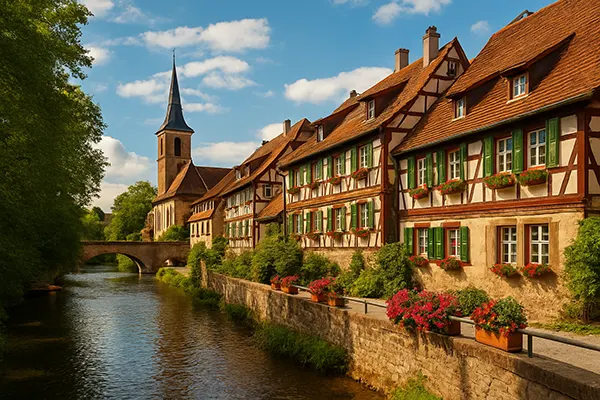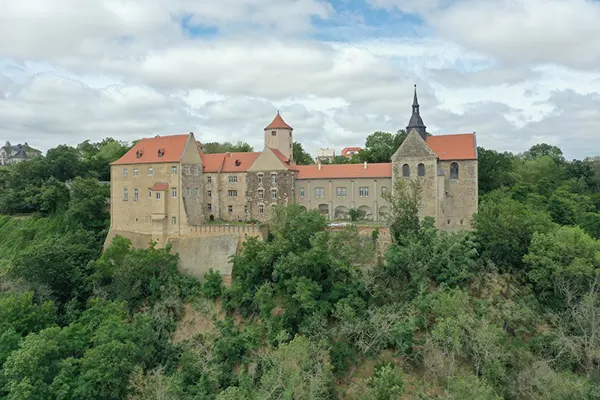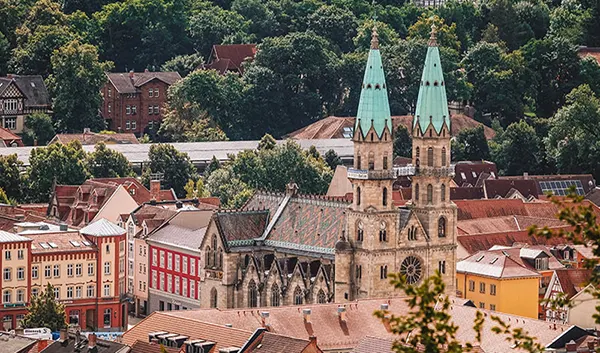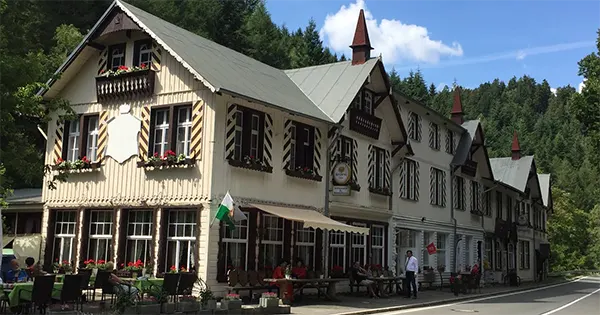
Romkerhall – The Smallest Kingdom in the World and Its Waterfall
Romkerhall, often referred to as the “smallest kingdom in the world”, is a unique destination in the Harz Mountains of Germany. Situated along the scenic B27 road between Goslar and Bad Harzburg, this location combines natural beauty with an intriguing backstory. The highlight is its artificial waterfall, dropping an impressive 64 metres, surrounded by dramatic cliffs and lush forest. Alongside the waterfall stands a charming hotel and restaurant, which together form the heart of this self-proclaimed “kingdom”. Visitors come not only for the striking views but also to experience the blend of history, storytelling, and outdoor adventure that Romkerhall offers.
The Story and Charm of Romkerhall
The origins of Romkerhall date back to the 19th century, when the area became a popular stop for travellers exploring the Harz Mountains. The hotel was constructed in 1863 and quickly became known as a comfortable retreat for hikers and nature lovers. The “kingdom” title is more of a playful marketing concept than a political reality – yet it has become an integral part of its identity, adding an element of curiosity for visitors. Inside the hotel, guests find a blend of rustic charm and antique details, creating a warm and authentic atmosphere that reflects the history of the region.
One of the most recognisable features of Romkerhall is its sense of being both secluded and accessible. Nestled between dense woodland and steep rock formations, it feels like a hidden enclave, yet it is easily reached by car or via hiking trails. The surrounding scenery changes dramatically with the seasons: autumn brings golden leaves, winter cloaks the area in snow, spring fills the air with fresh scents, and summer offers lush greenery and cooler mountain air. This constant transformation makes it appealing for repeat visits throughout the year.
Romkerhall is also known for its themed events and celebrations, often held within the hotel’s inviting dining spaces. These gatherings embrace local traditions, seasonal cuisine, and sometimes whimsical “royal” ceremonies, which add to the location’s character. For travellers seeking more than just a view, these experiences make the stop even more memorable.
The Artificial Waterfall
The 64-metre-high Romkerhall waterfall is not a natural formation but an engineering creation from the late 1800s. It was designed to enhance the beauty of the area and attract visitors at a time when tourism in the Harz region was flourishing. Fed by a mountain stream, the water is channelled over a cliff face, creating a spectacular curtain of spray that glistens in the sunlight. Despite being artificial, it harmonises with the surrounding environment so well that many are surprised to learn its origin.
In the warmer months, the waterfall provides a refreshing mist to those standing nearby, while in winter it can freeze into dramatic ice formations, drawing photographers and nature enthusiasts. Its location next to the hotel means guests can enjoy the sound of rushing water during their stay, adding to the overall sensory experience of Romkerhall. This proximity also makes it a convenient highlight for those on tight schedules, as the sight is just steps away from parking and accommodation.
The area around the waterfall is accessible via short paths, with viewpoints allowing visitors to appreciate its height and volume from different angles. Benches and small rest spots offer the chance to pause, take in the view, and enjoy the tranquillity of the Harz landscape.
Hiking and Scenic Routes
Romkerhall sits within a network of hiking trails that range from leisurely riverside walks to challenging climbs up rocky slopes. The surrounding Harz Mountains are renowned for their diverse terrain, and Romkerhall serves as an ideal starting point for exploring the area. Popular routes include paths that lead towards the Oker River valley, offering sweeping views of the water winding through the forest. Others venture higher into the hills, rewarding hikers with panoramic vistas of the region.
One of the most attractive aspects of hiking in this part of the Harz is the combination of natural and historical points of interest. Along the way, walkers encounter old stone bridges, remnants of mining history, and traditional half-timbered villages. The trails are well-marked, making it accessible even for those unfamiliar with the area. For visitors preferring shorter routes, there are circular paths that return to Romkerhall within a couple of hours, allowing time for a meal or drink at the hotel afterwards.
For the more adventurous, the nearby Harz National Park offers further opportunities for trekking and wildlife observation. The park is home to rare plant species, wild deer, and a variety of birds, making it an attractive destination for nature enthusiasts. Romkerhall’s location makes it possible to combine a comfortable stay with the thrill of exploring untamed landscapes.
Viewpoints and Photography Spots
Photographers often favour Romkerhall for its mix of dramatic rock formations, flowing water, and dense forest. From certain points along the trails, visitors can capture both the waterfall and the hotel framed by rugged cliffs. The changing light throughout the day transforms the scenery: early mornings bring soft mist, midday sun creates sharp contrasts, and evenings bathe the rocks in warm tones.
Beyond the immediate vicinity, elevated lookouts provide expansive views of the Harz Mountains stretching into the distance. These spots are particularly popular during autumn, when the foliage turns into a vivid tapestry of reds, yellows, and oranges. Even without professional equipment, visitors can leave with striking images that reflect the charm of the “kingdom”.
Those interested in night photography can take advantage of the area’s relatively low light pollution. On clear nights, the stars appear bright above the silhouette of the mountains, offering a peaceful conclusion to a day of exploration.
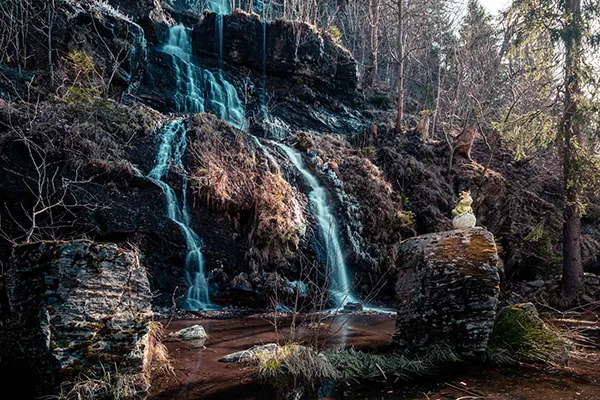
Planning a Visit
Visiting Romkerhall is straightforward, whether arriving by car or on foot from nearby towns. The location is well-signposted along the B27, with parking available for day visitors and overnight guests. Public transport connections to Goslar and Bad Harzburg make it possible to combine a visit with other attractions in the Harz region. Staying at the Romkerhall Hotel offers the advantage of being right next to the waterfall and within easy reach of multiple hiking routes.
The hotel provides a range of rooms, each decorated with a touch of historical style. The on-site restaurant serves both regional and international dishes, making it a pleasant place to relax after outdoor activities. Seasonal menus often feature local game, fresh trout, and hearty soups, reflecting the culinary traditions of Lower Saxony. For those on day trips, the restaurant is also open for casual meals and coffee breaks.
Before visiting, it is advisable to check opening times, especially in winter when weather conditions may affect accessibility to certain trails. Spring through autumn is generally the most popular period, but the frozen waterfall in colder months offers a completely different kind of beauty. Comfortable footwear, weather-appropriate clothing, and a camera are highly recommended for making the most of the trip.
Tips for Visitors
To fully enjoy Romkerhall, consider combining your visit with other attractions in the Harz region, such as the Brocken Mountain, the Rammelsberg mining museum, or the historic towns of Goslar and Wernigerode. These destinations are all within reasonable driving distance and provide additional cultural and natural experiences.
Weekdays tend to be less crowded, allowing for a more peaceful experience around the waterfall and trails. Early mornings are particularly serene, with fewer visitors and softer light for photography. Bringing a small picnic to enjoy by the river or at one of the nearby viewpoints is a pleasant way to extend your stay outdoors.
Finally, remember that while Romkerhall may be playfully known as a “kingdom”, it thrives on genuine hospitality, natural charm, and the enduring appeal of the Harz Mountains. Visitors leave with not just photographs, but lasting impressions of a place where nature and creativity meet in harmony.

